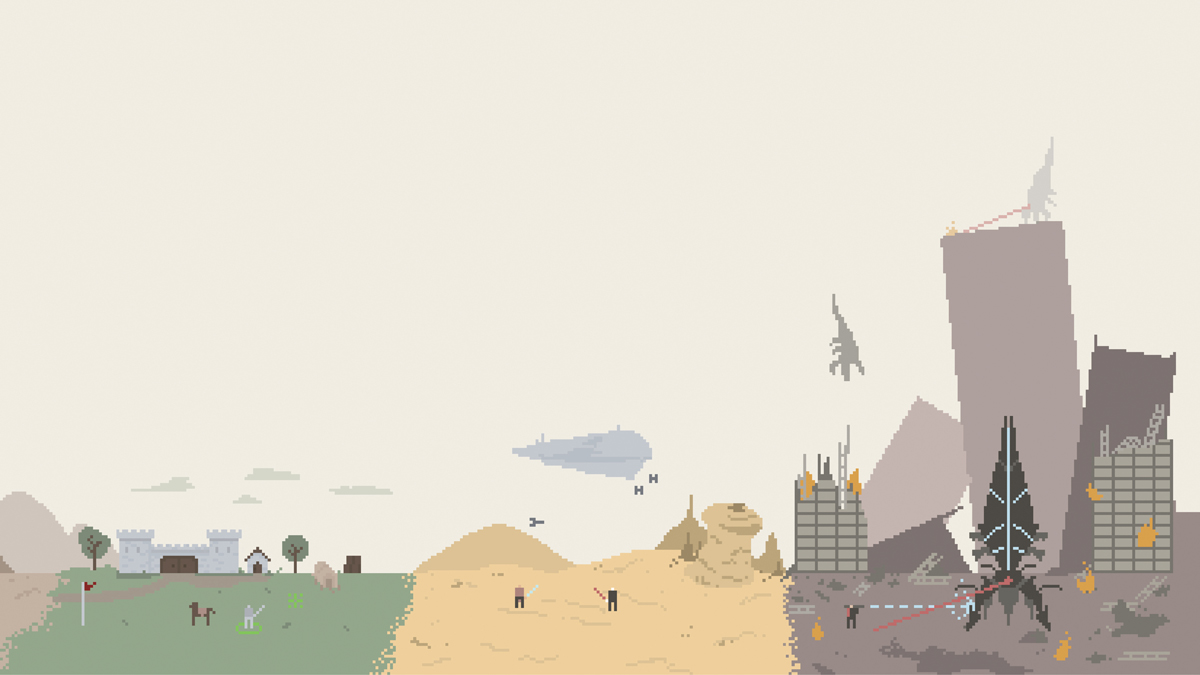 Alex Patterson
Alex PattersonShattered Steel, a mech simulation game with deformable terrain effects, was BioWare’s first demo. The player’s objective was to hunt down and eliminate a group of aliens. Originally submitted to 10 publishers, it resulted in seven offers. BioWare’s next project, a fantasy role-playing PC game called Baldur’s Gate, began development in Edmonton when University of Alberta grads Ray Muzyka, Greg Zeschuk, and Augustine Yip were practicing medicine. Their company was started in 1995. Having played many games and done some small-scale programming work during medical school, the team thought forming a company was an appealing venture. By 1998, Muzyka and Zeschuk departed from their medical practices to devote themselves entirely to BioWare while Yip continued in medicine. From there, it went on to release titles like Mass Effect and Dragon Age.
The company’s name, BioWare, is an homage to the founders’ academic roots. The company houses its headquarters along Edmonton’s Calgary Trail. It’s a strange location, given that most game development hotbeds are found in the United States in places like New York, Washington, and California; Canada isn’t widely recognized as a triple-A game-making hub, let alone the comparatively tiny YEG.
The name “BioWare” might ring a bell or two. Its sci-fi series, Mass Effect, remains one of the top-rated video games in history. Like many of the studio’s other games, it has spawned a cult following, along with endless Reddit posts — the Mass Effect subreddit alone boasts nearly 150,000 subscribers.
In 2008, the company was acquired for $860-million by one of the world’s top interactive entertainment publishers, Electronic Arts (EA), in a combined deal with Pandemic Studios. It was a signal of how far the company had come since starting in Zeschuk’s basement a little more than 10 years prior.
By 2012, both Muzyka and Zeschuk retired from the gaming industry and their roles in BioWare, with Muzyka moving into investment in technology, and medical and social entrepreneurs and Zeschuk diving into the craft beer scene, eventually forming his own craft beer web show called The Beer Diaries. Today, BioWare consists of two studios: its headquarters in Edmonton, and a second in Austin, Texas.
The lack of typicality in BioWare means that a lot goes into development without being noticed by the average consumer. Game development is almost movie-like in nature. Features can take months to create, and even the smallest cutscenes require diversity of talent and long days of hard work. Besides the Mass Effect and Dragon Age series, BioWare’s other works include Baldur’s Gate, Jade Empire, Neverwinter Nights, and Star Wars: Knights of the Old Republic. All of them presented notable challenges to their developers — some purposeful, some less so.
In Baldur’s Gate, the game’s demon dilemma is one example of how different disciplines — art, science, law, and more — cross over into the game development process. The game contains a character that, if attacked, keeps the appearance of a child and fights with the strength of a demon. In Germany, harming children is not allowed in games, so the developers created an in-game effect that prevented children from being harmed by attacks. The end result was a rampaging child-demon that could not be harmed. While players wouldn’t think of international publishing demands in this scenario, the dilemma was something developers had to focus on.
Normally, a writer needs to consider only one timeline and one set of outcomes, something that Luke Kristjansen, a senior writer and 20-year veteran at BioWare, knows too well. How many directions can your mind go? Will you choose to save the princess or turn tail in the final fight? Will you beeline for the ultimate objective or take your time and engage with all the side characters and side quests? BioWare stories have hundreds of outcomes that, if unchecked, could result in multiple possibilities for endgame.
“If you’re writing a novel, the limit of what you can put on the page is your imagination,” Kristjansen says. “If you’re writing a novel and you want an army coming over the hill, you can have (that) If I want an army, I need to go to creature art and ask, ‘Do we have horses?’ Maybe today we do, but maybe in six months, maybe we don’t.”
BioWare creates its games with a writing style that involves thinking of many different directions at the same time, sort of like a choose-your-own-adventure book — a technique known as “branching narratives.” Instead of thinking linearly about a character’s path, a writer must consider what will happen to that character if they are directed into a swamp, or if they choose to ignore a certain side quest. For many years, dedicated writing staff were rare at video game studios; studios either had other staff members write their games, which usually resulted in subpar work, or brought in freelancers after the majority of the game was finished. But the sheer amount of lines and writing needed for a BioWare game demands an in-house group. Mass Effect 3, for instance, contained over 40,000 lines of dialogue.
The majority of games being developed at BioWare feature plenty of player-generated character development. Instead of playing as predetermined characters, players are given a lot of freedom to choose their own play styles and in-game identities.
Case in point: BioWare sometimes has romance side-plots in their games, and a player who doesn’t engage with that is playing a fantasy game where they’re the lone hero in charge of a plucky group of people going up against the baddie. But on the flip side, the player who does get into that is now suddenly playing a romantic adventure where they have their love interest by their side as they face evil.
“That is a different kind of sub-genre, so you’re writing multiple genres at the same time and letting the player choose what they engage with,” Kristjansen says. “That (relinquishing of control) can be daunting for other writers from other media.”
Although this multi-directional approach makes for a longer, more involved production process, it ultimately speaks to BioWare’s mission to create rich stories, unforgettable characters, and vast worlds. It’s also what makes video games so different from other forms of entertainment.
Challenge, according to former Dragon Age series creative director Mike Laidlaw, is part of every BioWare role. Responsible for keeping Dragon Age in a consistent, coherent universe, he has had to wrestle with balancing direction and creative possibility for the last 14 years.
“There are times when people will reach out to me to tell me the games we make matter more to them than you might expect,” Laidlaw says. “(Something) like, ‘I was going through chemotherapy and I would take my laptop in with me, and you were the escape.’ That’s 200, 400 people’s efforts.”
The company continues to work on major video game projects with a focus on expansive in-game worlds, character development, and branching narratives. Part of the work is done by co-op students, interns, and junior team members — a great number of whom have ties to the U of A. From the day BioWare’s founders graduated from the school, the U of A has had a unique role in the company. One part of that relationship is its recruiting program, which studio recruiter Shanda Wood says has always sought out U of A students. BioWare offers co-op positions in nearly every area within the company, including art, design, and programming. Though there haven’t been co-op students in the writing department in Wood’s five years with the company, there are junior members on BioWare’s writing team. The company searches for hires who will speak up at meetings and bring in new ideas.
Specific examples of students making impacts can be found in many places, Laidlaw says. The titular dragons of the fantasy role-playing Dragon Age games, the first of which was released in 2009, were born almost directly from the passion of a U of A graduate. With six limbs, unusual mechanics, and unpredictable AI, the creatures involved unique programming that Laidlaw says turned them into one of the best features of the game.
So many U of A students have come through BioWare’s offices over the years that a great deal of the company’s former co-op students and newly graduated hires have come to lead the teams they once interned with. Janice Thoms, BioWare’s director of production and U of A computing science alumna, says the company has boasted an 85 to 90 per cent conversion rate — that is, when BioWare brought in new grads, there was a very high chance they would become full-time employees.
“Probably most of the folks we have (at BioWare) who’ve been around for a long time — so most of the people leading Anthem right now — graduated from the U of A,” Thoms says. “That team has had a massive impact on BioWare.”
The team working on Anthem, the upcoming open-world sci-fi roleplaying game set for release in 2018 on Windows, PS4, and Xbox One, she notes, also includes the people who worked on Mass Effect and Star Wars: Knights of the Old Republic before that.
It helps that BioWare’s location in Edmonton and Alberta makes the company naturally more attractive to burgeoning game developers. Artists, writers, designers, testers, developers, and recent graduates are all attracted to the company’s focus on narratives in game creation. Many students dream of working on BioWare projects after they graduate.
“Providing students an opportunity to get their feet wet in the games industry has been a huge advantage to us,” Thoms says.
This human connection to Edmonton is a big reason why the company has stayed in the city instead of moving to somewhere more focused on games and technology, like Silicon Valley. The location isn’t without problems, but certain advantages come from being in a city not historically known for gaming, Thoms says. And because the company is situated in a largely oil and gas economy, BioWare is able to provide some diversity of employment for people coming out of their degree programs.
“Any time we have new, fresh talent, we love to see that,” Wood says. “Any time we have a student come in from the University of Alberta or any other school, we’re constantly trying to pull their knowledge and creative mindset.”




